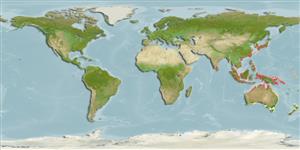分类 / Names
俗名 | 同种异名 | Catalog of Fishes(属, 种) | ITIS | CoL | WoRMS | Cloffa
Environment: milieu / climate zone / 深度上下限 / distribution range
生态学
海洋 礁区鱼类; 深度上下限 5 - 20 m (Ref. 90102). 热带
Indo-West Pacific: India east to Sagami Bay, Japan and China. A new record was reported from southern Indonesia (Ref. 5978).
印度-西太平洋: 印度东至日本的相模湾与中国。 一个新的记录被记录自印度尼西亚南部。 (参考文献 5978)
大小 / 重量 / 年龄
成熟度: Lm ? range ? - ? cm
Max length : 14.0 cm TL 雄鱼/尚未辨别雌雄; (Ref. 559)
背棘 (总数) : 10; 背的软条 (总数) : 12; 臀棘: 3; 臀鳍软条: 6. Distinguished from C. aprinus by the bright yellow coloration when viewed underwater (Ref. 48636).
Body shape (shape guide): short and / or deep; Cross section: compressed.
与 C. aprinus 区分了藉由鲜黄色的颜色当看在水中的.(参考文献 48636)
Occurs on rocky cliffs in deep water (Ref. 9710). Also inhabits muddy substrates in protected bays where wave action has no influence (Ref. 48636). Solitary (Ref 90102).
在深水中生活于岩石的悬崖。 (参考文献 9710) 也在遮蔽的内湾中居住于泥质底部在哪里不受波浪影响.(参考文献 48636)
Life cycle and mating behavior
成熟度 | 繁殖 | 产卵场 | 卵 | 孕卵数 | 仔鱼
Bi-directional sex change has been confirmed for this species (Ref. 103751). Sexual pattern seem to be intermediate between simultaneous and sequential hermaphroditism: individuals, at least under conditions of captivity, have the capacity to change sex in either direction, from functional male to functional female, or vice versa (Ref. 31569).印度-西太平洋: 印度东至日本的相模湾与中国。 一个新的记录被记录自印度尼西亚南部。 (参考文献 5978)
Masuda, H., K. Amaoka, C. Araga, T. Uyeno and T. Yoshino, 1984. The fishes of the Japanese Archipelago. Vol. 1. Tokai University Press, Tokyo, Japan. 437 p. (text). (Ref. 559)
世界自然保护联盟红皮书 (Ref. 130435: Version 2025-1)
人类利用
工具
特别资料
下载 XML
网络资源
Estimates based on models
Preferred temperature (参考文献
123201): 21.4 - 29.3, mean 28.7 °C (based on 1745 cells).
Phylogenetic diversity index (参考文献
82804): PD
50 = 0.5039 [Uniqueness, from 0.5 = low to 2.0 = high].
Bayesian length-weight: a=0.01445 (0.00715 - 0.02923), b=3.07 (2.89 - 3.25), in cm total length, based on LWR estimates for this species & (Sub)family-body (Ref.
93245).
营养阶层 (参考文献
69278): 4.0 ±0.67 se; based on food items.
Fishing Vulnerability (Ref.
59153): Low vulnerability (10 of 100).
🛈
